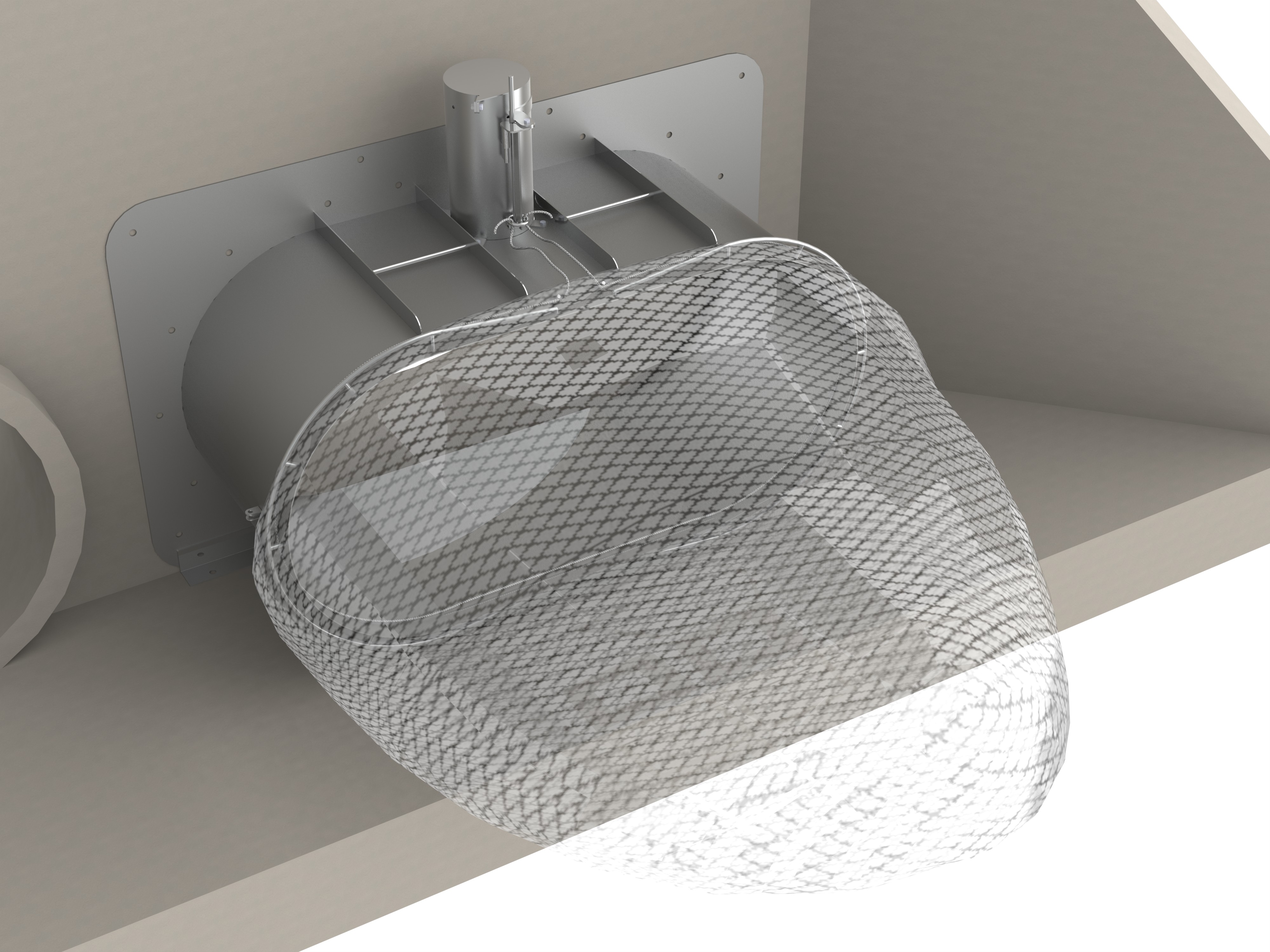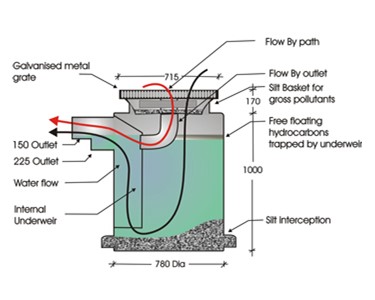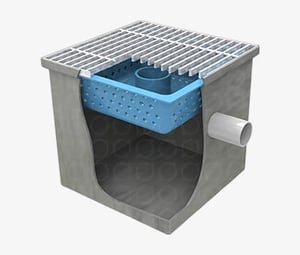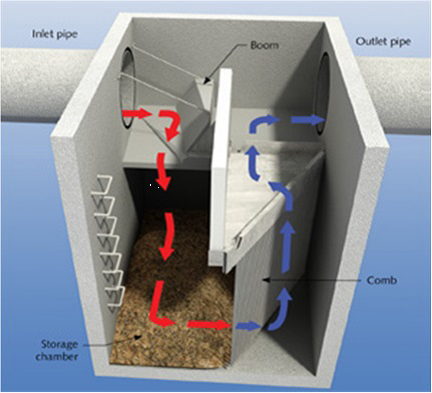Gross Pollutant Trap Inspections. Blacktown City Council within its boundaries has 160 gross pollutant traps which vary greatly in their size shape and form.
Gross Pollutant Traps Delivery Australia Wide
Since gross pollutant traps tend not to be effective in removing nutrient they are most often used as part of a treatment train with other stormwater treatment measures such as wetlands or bio-retention systems.

. They generally collect larger items from the water such as take away containers leaves bottles and plastic bags. The device includes a stainless steel outfall pipe extension combined with a large net. Up to 24 cash back Environmental Gross Pollutant Trap As discussed previously a gross pollutant trap is to be implemented at the downstream end of North Terrace at the end of and in line with the main 750mm stormwater collector pipe and.
The design allows for highly effective removal of Silt and Oil with minimal maintenance. The process for undertaking a life cycle costing analysis for gross pollutant traps is the same as described in Life-Cycle Costing - Constructed Wetlands and Life-Cycle Costing - Bioretention. VU total volume of all stormwater and trapped pollutants in the unit when it is operating at its peak design flow m 3.
Innovative Techniques for Designing Urban Stormwater Controls Fully updated to address the paradigm shift in the way stormwater is viewed and managed Design of Urban Stormwater Controls focuses on consolidating technologies to foster a convergence between traditional stormwater controls and green infrastructure. Gross Pollutant Traps Urban Stormwater Management Manual 34-1 341 PURPOSE AND DEFINITION Gross pollutant traps GPTs remove litter debris and coarse sediment from stormwater. On sites with steep grades GPTs may not operate effectively while on mild slopes head losses can cause local flooding.
This authoritative resource explains. The unique design of the HumeGard floating boom allows it to be modified to treat higher flows and capture more gross pollutants and sediment on request. From targeting visual contaminants such as plastic litter leaves or oils to pre-treatment of sediments prior to filtration devices ponds or wetlands Gross Pollutant Traps GPTs are a cost-effective way to reduce your sites contaminant loadings and.
Gross pollutant traps have traditionally been constructed as cages filters or wells but there are opportunities to investigate natural alternatives to these practices. The elected design has to stop silt particles that are. What do gross pollutant traps do.
The Halgan Environmental range of Gross Pollutant Traps GPTs are designed to remove particles greater than 1mm. Gross Pollutant Traps or GPTs are devises used to prevent large items polluting waterways. The real design challenge comes from constructing a solution thats self-sustaining.
Use of Gross Pollutant Trap GPT or trash trap to block the trash from entering the river system has been a common practice around the World. This indicates that the design of trash trap to block and remove waste from the flow of water in the stream is needed to prevent the operation of mini hydro from being disrupted. When this occurs maintenance is required immediately.
Gross Pollutant Traps may be used as the pretreatment for. The Ecosol GPT in-line end-of-line stormwater treatment solution is a non-blocking wet sump tangential filtration system that has designed been specifically designed to filter pollutants conveyed in stormwater conduits by capturing and retaining all contaminants larger than 3mm up to a designed treatable flow rate TFR. The basic elements of the trap are made from high strength steel-reinforced concrete.
TAC 2004 31430 x C 0. Settleable gross pollutants will also be removed by the advanced hydrodynamic separation but are not included in this figure. The unique and proven screen design conveys pollutants and sediment to.
For more information on the design of gross pollutant traps refer to Chapter 14 Other Measures in the WSUD Engineering. CDS gross pollutant traps GPTs are designed to capture and retain gross pollutants litter grit sediments and associated oils utilising patented CDS indirect screening technology. A number of these have been installed by Council however a large number have also been acquired by.
Any half-capable consulting service can design a litter trap or a grated pit aperture the kind of site that collects floating rubbish before it enters our waterways. Rocla offers a complete design service for CDS products that takes into account the catchments characteristics pollution load hydraulic site. Identify any physical site constraints eg.
Some designs also provide oil separation. Gross pollutant traps are not specifically designed to capture hydrocarbons though may do so during emergency spill events. Based on testing conducted by Hydro International and externally validated by The New Jersey Corporation for Advanced Technology NJCAT Coventry University and others.
For more information on the maintenance of gross pollutant traps refer to the Auckland Regional Council Technical Report. This figure includes pit traps. The unit is made up of basic building block components that are craned into an excavated pit and bolted together.
These substances are collectively referred to as Gross Pollutants. What is a gross pollutant trap. The Rocla CleansAll GPT is designed for ease of assembly.
The NetTech Gross Pollutant Trap is an outfall protection device that captures trash and debris from storm water runoff before it enters downstream receiving waters. Design Requirements for SBTR Traps The width of sediment trap is required to have a ratio length between 2 and 3. Topography soils geology overhead restrictions and services.
GPTs main function is water quality control. Design Process The key steps in the design process include. The range accommodates pipe sizes up to 600mm in diameter and flow rates up to 798 Ls allowing specific selection for most design criteria and treatment of up to 95 of annual stormwater runoff.
Efficiently remove floating pollutants. Simple design and durable components make installation and maintenance quick and simple. Gross pollutants traps GPTs are the oldest form and often most commonly applied stormwater quality improvement device in Australia and overseas.
Using vortex separation technology via our Continuous Separation Screen CSS which enables efficient treatment of sediment gross pollutants and hydrocarbons. A choice of lid options to suit all loading requirements. A GPT is a device that removes solids greater than 5 millimetres from runoff water.
They are used in stormwater drains urban wetlands airports beach fronts industrial plants flood plains and other locations. There are several gross pollutant traps suitable for the urban landscape including gully baskets in-ground GPTs trash racks and pipe nets.
Vortcapture Stormwater Gross Pollutant Trap Gpt Youtube

Gross Pollutant Trap Gpt For Sale Industrysearch Australia

Gross Pollutant Traps Stormwater360

Most Popular Stormwater Devices Stormwater Sydney

Your Guide To Gross Pollutant Traps Global Water

Nettech Gross Pollutant Trap Oldcastle Infrastructure

Gross Pollutant Traps Gpt City Of Melbourne Urban Water
Clt 004p Dragon Scale Filtration Gross Pollutant Trap Gpt Www Clevertek Com Au
0 comments
Post a Comment